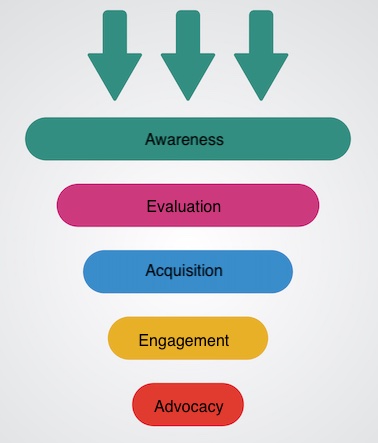How to Funnel Shoppers on Social Media
Marketing funnels help map the customer journey from awareness to endorsement after purchase. Understanding the different stages helps brands develop messages and content.
An ecommerce business might have a well-designed website and informative case studies, product videos, and sales content, but no strategy for the entire journey. The result is lower sales.
In this article, I’m going to share ideas on how to build a funnel on social media.
Social Media Funnel
On social media, a shopper could be meeting your brand for the first time, researching your products, researching the benefits, purchasing an item, and then recommending it to their friends. Social media thus covers the spectrum of the buying process – from awareness to advocacy.
- Awareness. How will potential customers find your brand?
- Evaluation. How will they use social media to compare your products to those of the competition?
- acquisition. How will you entice prospects to buy?
- Engagement. How will you use social media to keep in touch after a purchase?
- advocacy. How do you convince customers to recommend your company?
Therefore, the goal of the social media marketing funnel is a customer who is committed to your brand.

On social media, a customer journey begins with awareness and progresses through assessment, acquisition, engagement and ends in advocacy.
Awareness.
- Organic. Facebook Live, Instagram Live, Reels, Guest Posts on External Blogs, Ask Me Anything segments on Reddit, Group Chats on Linkedin or Facebook, Newsletters, Contests, and YouTube Videos.
- Paid. Advertising on Facebook, Instagram, WhatsApp, YouTube, email newsletters and external brands. Influencer Marketing.
Evaluation.
- Organic. Share positive reviews, testimonials, and “ask me anything” with your CEO. Create a Pinterest or Instagram shop. Publish product demos on YouTube. Share customer service requests on Twitter.
- Paid. Sponsor Facebook and Instagram posts with product reviews, third-party blog posts, and remarketing ads with product details and insights.
acquisition
- Organic. Run social media contests with purchase incentives, time-limited coupons, and email signups with free e-books or guides.
- Paid. Facebook and Instagram Lead Ads. Pinterest buy buttons. Facebook remarketing.
engagement
- Organic. Host Twitter chats. Answer questions in live sessions on Facebook and Instagram. Create offers for existing customers, including pre-sale options.
- Paid. Sponsored Facebook posts, PR pitches and a private new product showcase.
advocacy
- Organic. Create communities, fansites and group chats for customers. Launch customer-only contests or referral marketing with incentives. Recruit customer representatives.
what is the purpose
Social media can increase brand awareness and increase sales. However, in my experience, it is crucial that each stage of the funnel has a purpose.